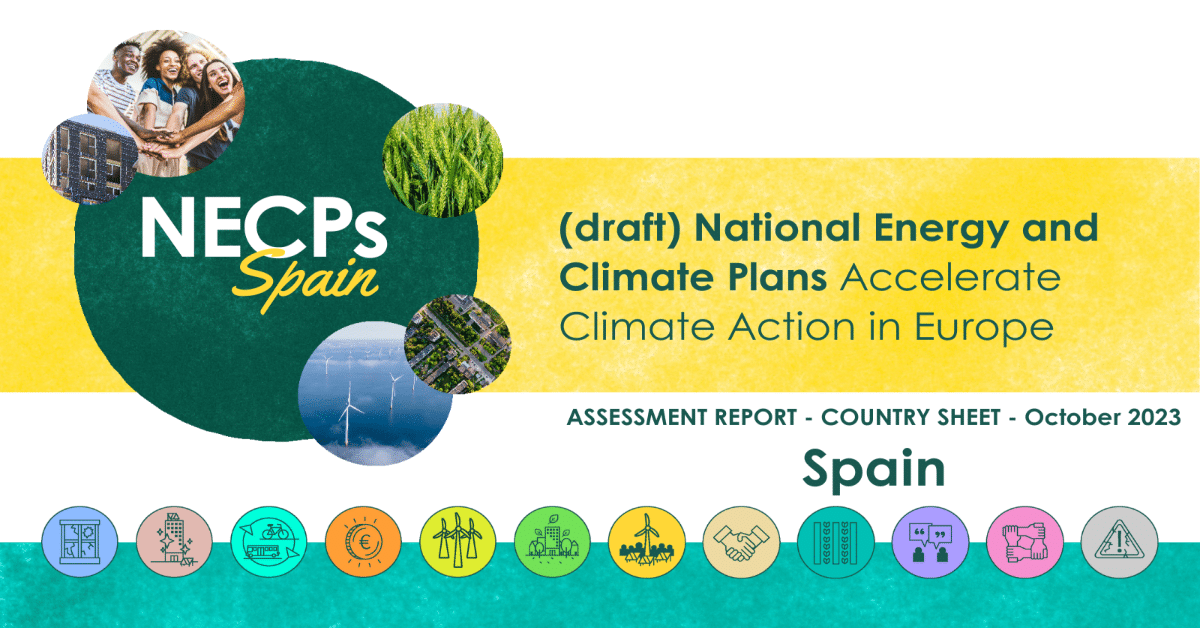Spain submitted its draft National Energy and Climate Plan (NECP) update on time. This assessment is based on the draft available on the Commission’s website. Spain does not move towards a 1.5°C trajectory. However, the climate target surpasses the minimum EU requirement for effort sharing, and the renewables contribution is in line with the EU 2030 targets. Only the energy efficiency contribution is not ambitious enough to align with the EU 2030 energy efficiency target. Overall, measures seem to support the targets and have grown (107) compared to the 2019 NECP (78). However the draft still includes too many policies and measures that perpetuate the use of fossil fuels, notably fossil gas.
RECOMMENDATIONS
- Set higher and binding climate targets that take into account historical responsibilities and are in line with a 1.5°C trajectory;
- Improve the plan for renewables deployment, which currently concentrates too much on mega-projects on a few specific areas, together with local authorities and communities;
- Phase out fossil fuels – their share remains too high in 2030 – and set a 100% renewables target in electricity generation by 2030.
Climate Ambition
The draft projects a 2030 economy-wide target of -32% compared to 1990 levels and a 2030 non-ETS target of -43% compared to 2005 levels – which is higher than in the 2019 NECP (-39%) but also higher than the (unambitious) target set in the Effort-Sharing Regulation (-37.7%). These targets are not binding, but represent the outcome of the projected decarbonisation impacts of policies and measures (PAMs) laid out in the plan. Also, they are in line with climate neutrality by 2050 and the EU targets, but still not in line with a 1.5°C trajectory that should take into account Spain’s (and the EU’s) historical responsibility and capacity to act.
13 additional climate PAMs are included compared to the 2019 NECP. While being overall feasible and consistent with the targets, some can be improved and some should be reformulated. For transport, a dedicated state fund should be created for financing public transport and electric mobility (EV subsidies, charging points). For agriculture, behavioural PAMs should be included (e.g. promotion of more sustainable diets), as well as climate and biodiversity certifications. For waste, reuse and recycling of materials must be prioritised, together with research and development for the materials needed for the transition. A carbon absorption target should be set.
Energy Transition
Spain sets a renewable energy contribution of 48% which will be in line with the Governance Regulation formula benchmark to reach the binding EU 2030 renewable energy share of 42.5%. PAMs are credible but should be improved. The plan lacks a planning framework at the regional level which would identify areas of low environmental impact to be used for renewables installations. The target for installed self-consumption by 2030, which was increased from 9-14 GW to 19 GW, must be further increased, and supported by an appropriate regulatory framework for energy communities that facilitates their creation. Finally, the plan does not include information on the origin, type and quantities of biomass that corresponds to the 2030 renewable energy target.
On energy savings, the draft NECP includes a level of consumption in 2030 which amounts to 96.7 Mtoe of primary energy and a binding level of 70.2 Mtoe of final energy. The objective is set compared to PRIMES 2007. The 2030 consumption levels are not in line with the requirements of the 2023 Energy Efficiency Directive (EED) and with the 2030 EU energy efficiency target. The gap towards the required contribution as per formula in the 2023 directive amounts to 4.82 Mtoe for final energy; with a possible deviation of 2.5% the gap would still be at 3.19 Mtoe. For primary energy consumption, the gap is 14.92 Mtoe. Energy efficiency measures are expanded from 16 to 23 measures compared to the 2019 integrated NECP and many measures are described in detail, including with regards to expected energy savings. Especially for measures concerning the renovation of buildings (measures 2.17 and 2.8) more funding is needed.
FOSSIL FUELS ALERT
- Fossil gas – The plan does not contain any plans to phase out fossil gas. On the contrary, it includes several measures that perpetuate the use of fossil gas directly or indirectly (such as measure 3.2, 4.9, 4.10, 4.11 and 2.21).
FALSE SOLUTION ALERT
- CCUS – The draft plan foresees an important role of and investments in Carbon Capture Utilisation and Storage in the decarbonisation of the hard-to abate industry sector.
- Slow nuclear phaseout – While installed capacity decreases in the period 2021-2030, nuclear still contributes to 11% of gross electricity generation and 10% of total primary energy consumption by 2030.
IS MONEY WHERE THE MOUTH IS?
- Only energy efficiency and internal energy market PAMs include a specific section on financial needs and public funding sources (and not in all cases either); the others are not detailed enough.
- Overall, EU funding instruments – notably the Recovery and Resilience Plan and the Strategic Projects for its implementation (PERTE) – are well integrated in the draft NECP planning. Cohesion Policy funding should support NECP measures that are small-scale and in rural areas, rather than big projects.
SNEAKY SUBSIDIES
- The draft presents a table that includes fossil fuel subsidies (Annex A, section A.5.6), but it does not mention plans for their phaseout, as the last column is empty.
- Resources derived from their phaseout should be directed towards a rehabilitation plan for homes, starting with the most vulnerable ones, to reduce the demand for fossil gas.
PUBLIC PARTICIPATION
- Public consultations were insufficient during the drafting phase. The Ministry held two debate sessions in Spring 2023, but these were only open to selected stakeholders, organised with pre-set questions and no presentation of drafts or scenarios. A public consultation only opened in the summer, after the draft NECP update was published.
- Multilevel dialogues do not exist.
Download spain country sheet NECP assessment report
Download FULL NECP assessment report
PREVIOUS
NEXT

